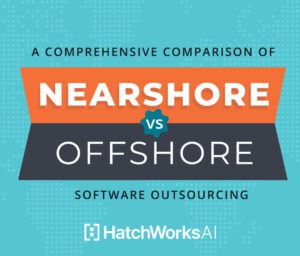Outsourcing myths.
They’re everywhere.
From whispered boardroom conversations to heated debates at tech conferences, these myths shape decisions, often to a company’s detriment.
But what if we told you that much of what you’ve heard is just… noise? And that, of all the outsourcing models and third party options, Nearshore is the one proving the naysayers wrong.

In this article, we’re separating fact from fiction so that the opportunity for faster, cheaper, high quality output is never missed again.
Keep reading to see what myths we’ve debunked and 3 real-life examples of the Nearshore model at work.
Outsourcing Myths Debunked: The Nearshore Advantage
For years, companies have turned to external teams to handle tasks they can’t manage in-house.
Sometimes they even look abroad (offshore), where they can get the work done at a reduced cost.
But lately, a new star has risen in the outsourcing world: Nearshore outsourcing.
According to a recent report by Forrester, 39% of technology leaders intend to increase their use of Nearshore services.
Nearshore is where companies outsource to neighboring, low cost countries with a similar time zone. If you’re US based, that means looking south to Latin America.
It’s a model that works especially well for companies in need of software development. And it’s no wonder when 53% of companies struggle to recruit in-house developers with the skills the business needs.
Nearshore Software Development gives them access to that talent and debunks many preconceived limitations of outsourcing abroad such as language barriers, time-zone issues, poor work quality, hidden costs, and more.
Let’s look at the 8 most common misconceptions companies have about outsourcing and put them to bed once and for all with Nearshore Software Development as an option.
- Myth 1: There are Language and Cultural Barriers in Outsourcing
- Myth 2: Outsourcing Compromises Quality
- Myth 3: Outsourcing Leads to Time Zone Challenges
- Myth 4: Outsourcing Poses Security Risks
- Myth 5: There are Hidden Costs in Outsourcing
- Myth 6: Outsourced Teams Have Limited Tech Knowledge
- Myth 7: Outsourcing is Only for Short-Term Projects
- Myth 8: Outsourced Teams Lack Innovation
Myth 1: There are Language and Cultural Barriers in Outsourcing
If you’re outsourcing to another country, especially one with a different language, then language mishaps and cultural misunderstandings are part of the package, right?
Well, not if you choose the country and your outsourcing providers correctly.
With Nearshore, you’re partnering with Latin American countries. This region has more in common with the US than you’d think. From shared cultural events to similar business etiquettes, the alignment is surprisingly close.
And language? It’s less of a barrier than many assume. Latin America has a high adoption of the English language, in part because it’s so close.
This ensures that communication flows smoothly, and misunderstandings are kept to a minimum.
So, while language and culture can be concerns in some outsourcing models, Nearshore offers a refreshing alternative. You’ll find Central and South America even watching the same Netflix shows as us. These small consistencies in culture create a base of comradery and trust.
|
Myth
|
Reality
|
|---|---|
|
Outsourcing leads to significant language and cultural differences that hinder communication.
|
Nearshore regions often share cultural similarities with their clients, and professionals are fluent in multiple languages (including English), ensuring seamless communication.
|
Myth 2: Outsourcing Compromises Quality
Those who choose to outsource software development may expect lower quality work. Or that expectation may prevent you from investing in offshore or Nearshore development altogether.
But when you opt for Nearshore Software Development, you’re not trading quality for cost.
In fact, Nearshore teams are known for their commitment to excellence. They’re equipped with the latest tools, methodologies, and a drive to deliver top-notch software solutions.
And if you want the absolute best, HackerRank reports software developers from Latin America are among the top-rated developers globally.
At HatchWorks, our US-based team makes sure your project is assigned to Nearshore developers who have the necessary skills, ensuring the final product not only meets but often exceeds expectations.
|
Myth
|
Reality
|
|---|---|
|
Outsourcing means settling for lower quality.
|
Nearshore teams maintain high standards, often delivering superior software solutions compared to distant offshore alternatives.
|
Myth 3: Outsourcing Leads to Time Zone Challenges
We get it. Working with a team 7-10 hours ahead of you can disrupt communication and delay progress. You send an important update or ask a time sensitive question only to be met with silence.
Nearshore Development avoids that completely through its time zone friendly model.
By partnering with teams in neighboring countries, you’re working with just a minimal time zone difference, if there’s a difference at all. This means more overlapping work hours, quicker responses, and real-time collaboration.
With Nearshore, you get the efficiency of working with a local team, minus the hefty price tag. It’s a win-win for project timelines and team synergy.
|
Myth
|
Reality
|
|---|---|
|
Collaborating with outsourced teams results in time zone difficulties and project delays.
|
Nearshore development offers minimal time zone differences, promoting real-time collaboration and efficient project management.
|
Myth 4: Outsourcing Poses Security Risks
Offshore outsourcing can often mean sharing sensitive data across borders, and with that comes the fear of data breaches, unauthorized access, or even misuse of intellectual property.
After all, these companies might not have the same stringent security protocols or legal frameworks in place that you do.
Nearshore service providers, especially the reputable ones, are acutely aware of these concerns.
It’s worth partnering with a US-based provider that factors in security concerns and is accessible to answer any questions you may have.
|
Myth
|
Reality
|
|---|---|
|
Outsourcing increases risks related to data security and intellectual property protection.
|
Reputable Nearshore providers prioritize client data protection and adhere to international security standards.
|
Myth 5: There are Hidden Costs in Outsourcing
When you fly on a budget airline, the fees on top of the ticket itself add up quickly. And it leaves you feeling bamboozled and frustrated.
With outsourcing, you may fear a similar experience. Hidden costs can pop up from unexpected fees, communication breakdowns leading to project reworks, or even extended timelines due to misalignment.
However, Nearshore Development, especially with providers like HatchWorks, tackles these concerns head-on.
First, they prioritize transparency. This means clear contracts that lay out all costs upfront, leaving no room for surprise charges. Plus, their proximity and aligned time zones reduce communication mishaps, ensuring that projects stay on track and within budget.
HatchWorks, for instance, emphasizes regular check-ins and updates, ensuring that both parties are aligned, reducing the chances of costly misunderstandings.
|
Myth
|
Reality
|
|---|---|
|
Outsourcing, while appearing cost-effective, has hidden expenses.
|
Nearshore Development ensures transparency, clear contracts, and no unexpected costs, providing a cost-effective solution.
|
Myth 6: Outsourced Teams Have Limited Tech Knowledge
There’s a lingering belief that if you’re partnering with an outsourcing company, you’ll be getting a team that’s only versed in a handful of outdated technologies.
It suggests that while these teams might be more affordable, they might not offer the competitive advantage modern businesses seek.
This probably stems from the fact that many offshore companies are third-world economies.
Nearshore Development proves this isn’t the case, or at least, it doesn’t have to be.
HatchWork’s Nearshore teams aren’t just tech-savvy; they’re at the forefront of technological innovation.
Committed to maintaining a competitive advantage, the top Nearshore providers invest heavily in continuous training, ensuring their teams are adept across a broad spectrum of tech stacks. From legacy systems to the latest advancements in AI and cloud computing, they’ve got it covered.
|
Myth
|
Reality
|
|---|---|
|
Outsourced teams specialize only in a narrow range of technologies.
|
Nearshore teams boast diverse expertise across various tech stacks, staying updated with the latest technologies.
|
Myth 7: Outsourcing is Only for Short-Term Projects
Businesses often outsource small, short term projects they don’t have time to take on in house. They treat it as a way to take projects off their plate rather than as a way to build long-term, high-impact projects.
But that doesn’t have to be the case and it shouldn’t be. HatchWork’s Nearshore teams, with their dedication, expertise, and minimal turnover make a great outsourcing partner.
That’s because they invest in understanding a company’s goals, ethos, and future plans. This alignment means that businesses can rely on them not just for one project, but as a consistent, reliable tech partner for the long term.
So, while outsourcing can cater to short-term needs, it’s also a powerful strategy for businesses looking to forge lasting, value-driven partnerships.
|
Myth
|
Reality
|
|---|---|
|
Outsourcing is suitable only for short-term engagements.
|
Many businesses form long-term partnerships with Nearshore teams, benefiting from their dedication and expertise.
|
Myth 8: Outsourced Teams Lack Innovation
There’s a stereotype that outsourced teams just follow instructions, lacking the spark to introduce fresh, innovative ideas. But this couldn’t be further from the truth.
With the right outsourcing team, you’re getting an extension of your business, and a group of developers who want to problem solve with you, bringing their years of experience and skills to your service. They even rely on their extensive experience and knowledge to guide you toward the right solutions and methods for your project.
Instead of just executing tasks, they often challenge the status quo, bringing in fresh perspectives and novel solutions.
In fact, their exposure to various projects and industries equips them with a unique lens, driving innovation and pushing boundaries.
|
Myth
|
Reality
|
|---|---|
|
Outsourced teams don't bring innovative ideas to the table.
|
Nearshore developers, with their diverse experiences and fresh perspectives, often drive innovation and offer creative solutions.
|
Examples of Successful Outsourcing
How do we know the 8 myths are actually myths? Because we’ve seen firsthand how outsourcing can lead to transformative success at reduced costs for clients.
Here are 3 examples of our Nearshore Software Development services at work:
AWS Development for a Staffing Company
Our relationship with this client began in 2017 and continues to this day.
For this project we built an AWS end-to-end solution that automated processes within their company. The client didn’t just want execution, they wanted us to ideate and problem solve with them as true partners.
The result? Their team has been able to track an increase in revenue along with the success of the product.
Quite frankly, we couldn’t have done what we’ve done without HatchWorks Technologies."
CTO, Staffing Company
This goes to show that the right outsourcing partner can be instrumental in achieving business goals and that they can be a long term, enduring partner in your software development work.
Software Solution for DesignIntelligence
Our collaboration with DesignIntelligence, a leader in the architecture, engineering, construction, and design industries, began with a clear objective: help them build a platform where firms in these industries could find the right talent and where that talent could find their ideal job roles.
They wanted more than just a job board; they sought a solution that would provide rich, detailed profiles while ensuring professionals’ anonymity and protection against biases.
HatchWorks was brought on board to bring this vision to life not just as an executor but as a strategic partner who could align DesignIntelligence’s vision and goals with user needs and the new platform’s technical capabilities.
This platform allowed professionals to create detailed profiles, showcasing their skills and experience in a way that no other platform did.
The result? A platform MVP built in 3 months where firms could send connection requests to potential candidates, who could then decide if they wanted to reveal their full profile and connect.
Tom Spahn, Design Intelligence’s Managing Partner, found our ability to stick to budget and timeline an invaluable part of the process.
VR Development Services for Gaming Development Company
When a gaming company needed their video game ported to the Meta Quest 2 VR headset, they turned to us to make it reality.
The game was not only ported but optimized for the Meta Quest 2, ensuring smooth gameplay and high-quality graphics.
In their review they said, “We’d also like to shout out Claudio (LATAM General Manager); he was efficient, professional, and an outstanding communicator.”
It’s a perfect example of how using Nearshore Software Development doesn’t mean you’ll compromise on clear, efficient communication.
And overall, the client was thrilled with our commitment and ability to deliver excellent software.
HatchWorks went above and beyond."
Jake Witherell, COO, Schell Games
Choose an Outsourcing Company You Can Trust to Do Great Work
With HatchWorks you’re partnering with a US-based team and Nearshore developers that understands your needs, speaks your language, and operates in a similar time zone.
From our rigorous 5-step screening process to our impressive 98.5% retention rate, we ensure your project stays on track and that you get a true partner.
Ready to experience the transformative power of Nearshore outsourcing?
Contact HatchWorks today and get your project off the ground.
Hatchworks: Your US-Based Nearshore Software Development Partner
HatchWorks is a US-based Nearshore software development partner that combines local solutions practice with the affordability and scale of Nearshore outsourcing, all in your time zone.
Start your project in as little as two weeks and cut your software development costs in half.




